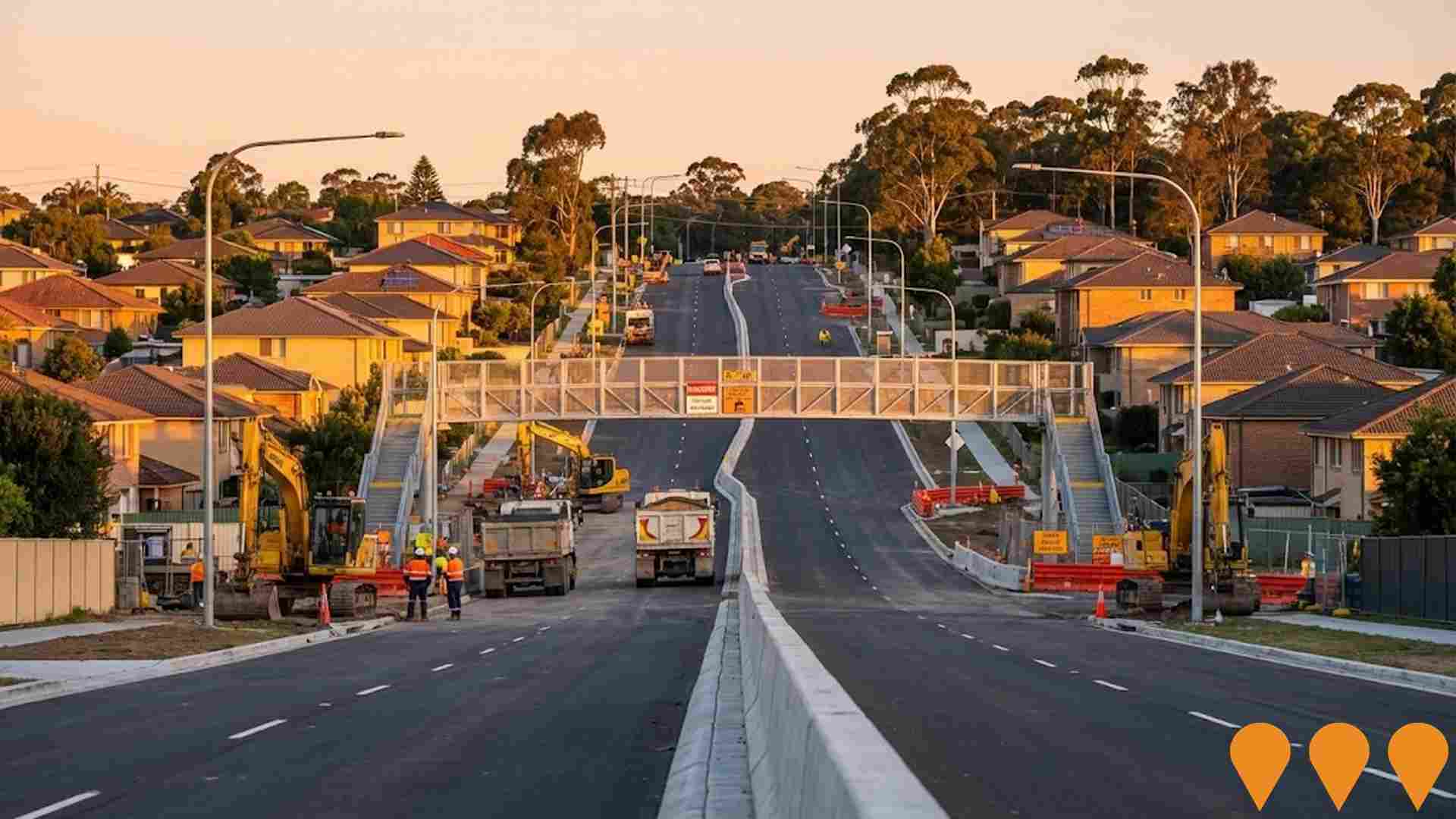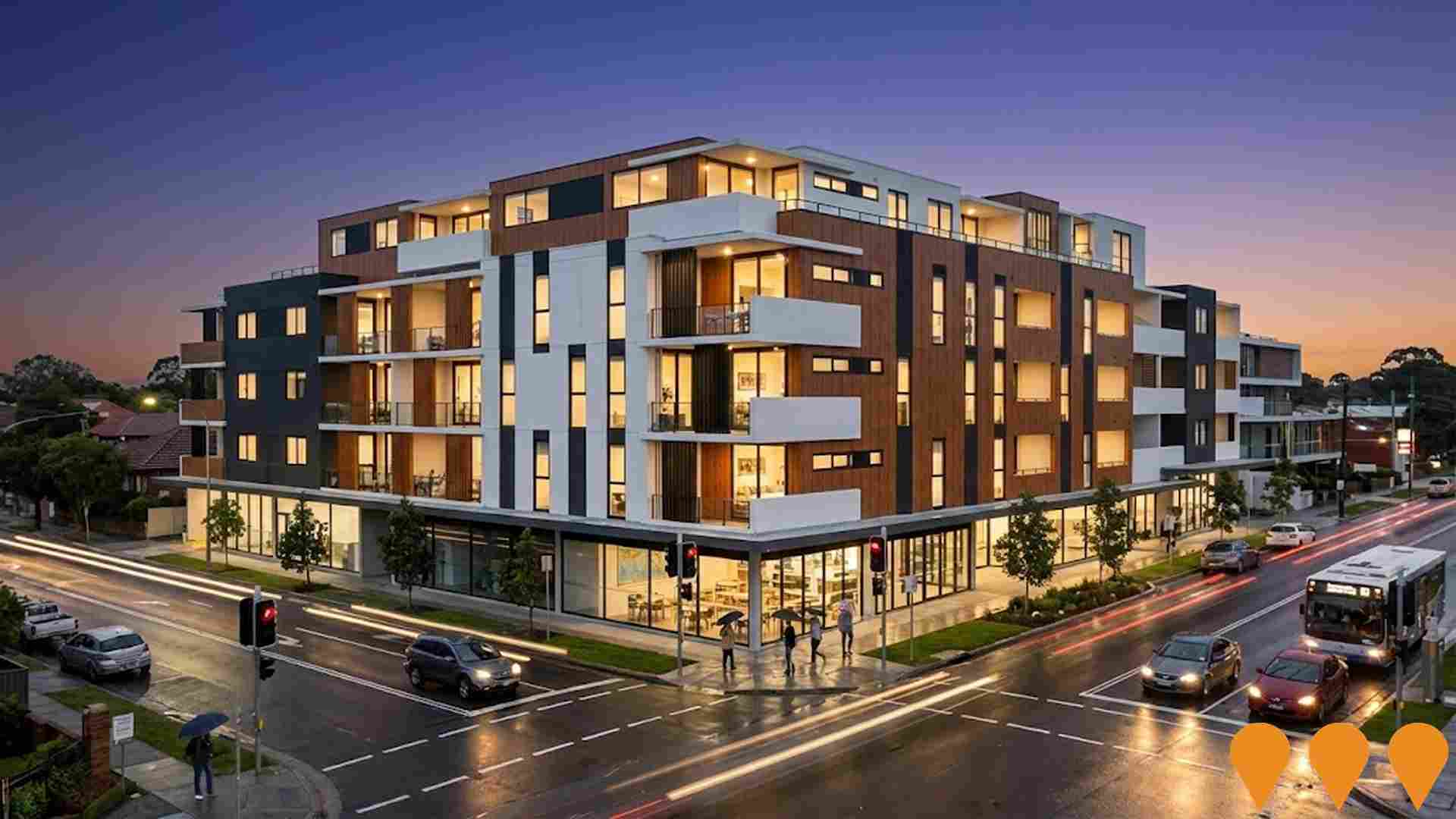Chart Color Schemes
est. as @ -- *
ABS ERP | -- people | --
2021 Census | -- people
Sales Activity
Curious about local property values? Filter the chart to assess the volume and appreciation (including resales) trends and regional comparisons, or scroll to the map below view this information at an individual property level.
Find a Recent Sale
Sales Detail
Population
An assessment of population growth drivers in Narwee - Beverly Hills reveals an overall ranking slightly below national averages considering recent, and medium term trends
Narwee - Beverly Hills' population, according to AreaSearch's analysis, stands at around 13,971 as of November 2025. This figure indicates a rise of 180 individuals (1.3%) since the 2021 Census, which recorded a population of 13,791. The increase is inferred from ABS's estimated resident population of 13,981 in June 2024 and an additional 31 validated new addresses post-Census date. This results in a population density ratio of 4,121 persons per square kilometer, placing the area within the top 10% nationally assessed by AreaSearch, highlighting its high-demand land resource status. Overseas migration drove recent growth, contributing approximately 87.4% of overall population gains.
AreaSearch employs ABS/Geoscience Australia projections for each SA2 area, released in 2024 with a base year of 2022. For uncovered areas, NSW State Government's SA2 level projections from 2022 (base year: 2021) are used. Growth rates by age group from these aggregations are applied to all areas for years 2032 to 2041. Future demographic trends suggest a population increase slightly below the national median statistical areas' average, with an expected growth of 1,100 persons by 2041 based on current numbers, translating to a total gain of 7.9% over 17 years.
Frequently Asked Questions - Population
Development
AreaSearch assessment of residential development drivers sees a low level of activity in Narwee - Beverly Hills, placing the area among the bottom 25% of areas assessed nationally
Narwee - Beverly Hills has seen approximately 45 new homes approved annually. Over the past five financial years, from FY21 to FY25, around 226 homes were approved. By June 30, 2026, a total of 8 homes had been approved in FY26.
Despite population decline in recent years, new supply has likely kept pace with demand, providing good choices for buyers. The average construction cost value of new properties is $378,000. This financial year, $1.9 million in commercial development approvals have been recorded, indicating the area's residential focus. Comparatively, Narwee - Beverly Hills has 15% less new development per capita than Greater Sydney. Nationally, it ranks at the 38th percentile for areas assessed, resulting in relatively constrained buyer choice and supporting interest in existing dwellings.
New building activity shows a split of 47% detached houses and 53% medium to high-density housing, offering affordable entry pathways and attracting downsizers, investors, and first-time purchasers. With around 441 people per dwelling approval, the area exhibits signs of a developed market. Population forecasts indicate Narwee - Beverly Hills will gain approximately 1,104 residents by 2041. Based on current development patterns, new housing supply should readily meet demand, offering good conditions for buyers and potentially facilitating population growth beyond current projections.
Frequently Asked Questions - Development
Infrastructure
Narwee - Beverly Hills has very high levels of nearby infrastructure activity, ranking in the top 10% nationally
Changes to local infrastructure significantly impact an area's performance. AreaSearch has identified ten projects likely affecting the region. Notable initiatives include Rail Service Improvement Program - T4 Illawarra & Eastern Suburbs Line, Beverly Hills Town Centre Master Plan, Beverly Hills Town Centre (West) Planning Proposal, and Canterbury Road Mixed-Use Development - Roselands. The following list details those most relevant.
Professional plan users can use the search below to filter and access additional projects.
INFRASTRUCTURE SEARCH
 Denotes AI-based impression for illustrative purposes only, not to be taken as definitive under any circumstances. Please follow links and conduct other investigations from the project's source for actual imagery. Developers and project owners wishing us to use original imagery please Contact Us and we will do so.
Denotes AI-based impression for illustrative purposes only, not to be taken as definitive under any circumstances. Please follow links and conduct other investigations from the project's source for actual imagery. Developers and project owners wishing us to use original imagery please Contact Us and we will do so.
Frequently Asked Questions - Infrastructure
Sydney Metro City & Southwest
30km metro rail extension from Chatswood to Bankstown via the Sydney CBD, including 15.5km of new twin tunnels under Sydney Harbour and the CBD and the upgrade of the existing T3 Bankstown Line to metro standards. The Chatswood to Sydenham section (including new stations at Crows Nest, Victoria Cross, Barangaroo, Martin Place, Pitt Street, Waterloo and upgrade of Central) opened on 19 August 2024. The final Sydenham to Bankstown section is now under construction and scheduled to open in 2026 following resolution of industrial disputes. Features driverless trains, platform screen doors and full accessibility. Total project cost approximately A$21.6 billion (2024 figures).
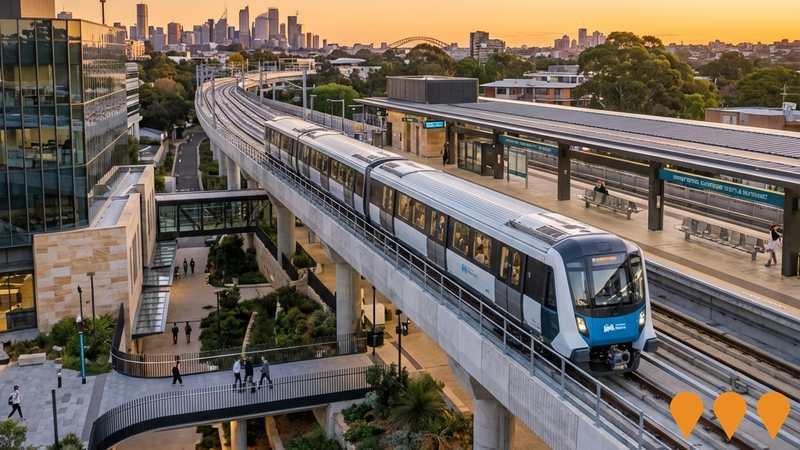
Rail Service Improvement Program - T4 Illawarra & Eastern Suburbs Line
Ongoing major upgrade program delivering more reliable and frequent services on the T4 Illawarra and Eastern Suburbs Line. Works include Digital Systems signalling upgrades (now in delivery), platform extensions, new crossovers, power supply upgrades, Waterfall stabling yard, and accessibility improvements at multiple stations. The program will enable a 30% increase in peak-hour services and supports the introduction of new NIF (New Intercity Fleet) trains. Delivery is staged, with major packages continuing through to 2028.
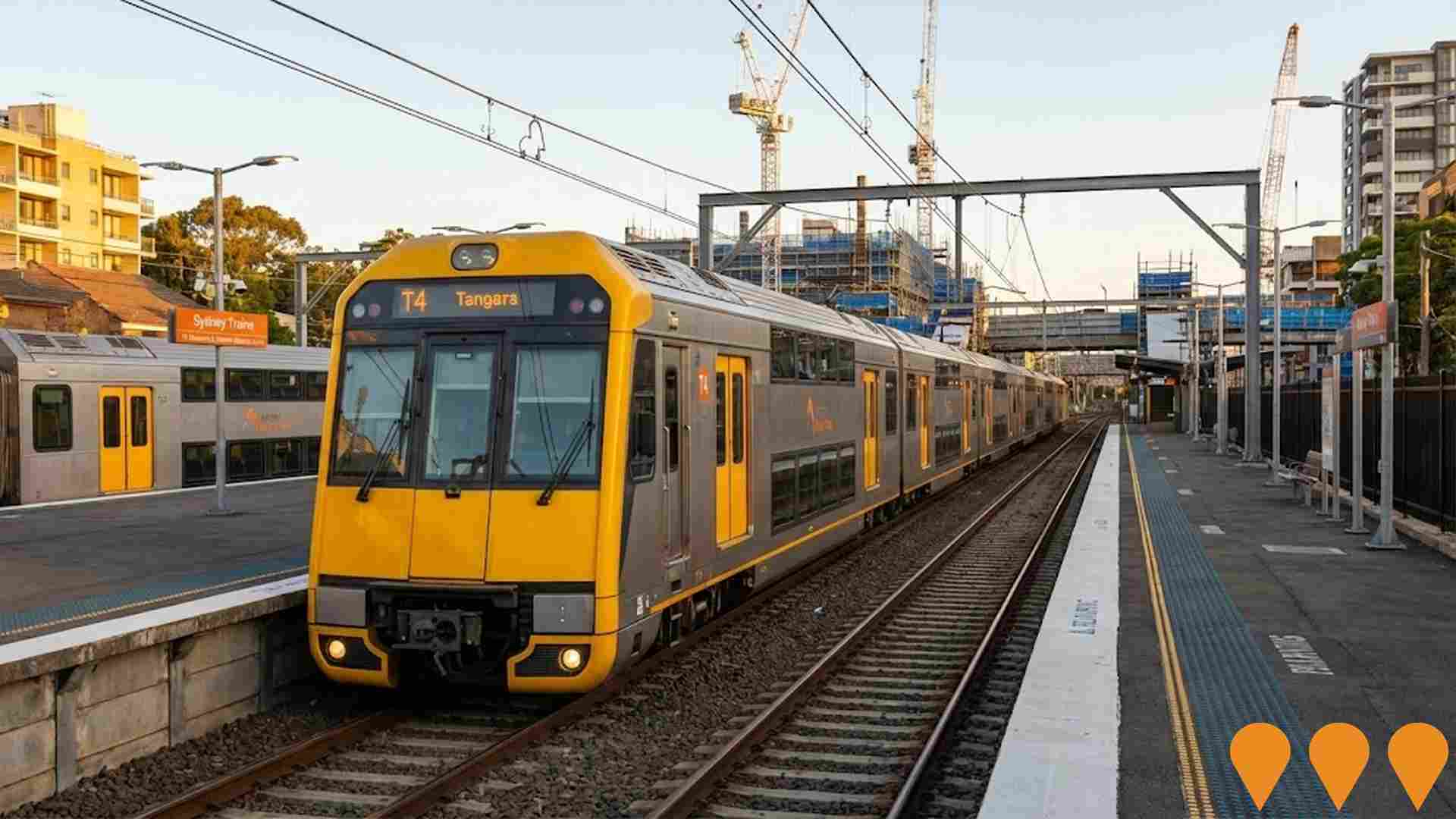
Beverly Hills Town Centre (West) Planning Proposal
A major planning proposal seeking to amend the Georges River Local Environmental Plan 2021 to facilitate mixed-use redevelopment of a 1.6-hectare site (52 contiguous allotments) on the western side of King Georges Road. The proposal aims to deliver approximately 500 residential dwellings along with retail, commercial, dining and entertainment floor space. The project is currently under State assessment, with the Gateway Panel having reviewed the proposal in February 2025. Due to flooding and gas pipeline risks, the project has been split, with properties 465-511 King Georges Road progressing while 409-463 King Georges Road remain on hold pending independent hazard review. The proposal seeks to increase building heights from 15 meters to between 44-50 meters (up to 15 storeys) and increase floor space ratios to facilitate urban renewal of this underperforming town centre located near Beverly Hills railway station.

Sydney Metro City & Southwest - Sydenham to Bankstown (T3 Bankstown Line Conversion)
Conversion of the existing 13.5km T3 Bankstown Line between Sydenham and Bankstown to fully automated metro standards as the final stage of Sydney Metro City & Southwest. Includes upgrading 10 stations (Marrickville to Bankstown) plus Sydenham interchange with platform screen doors (plus mechanical gap fillers on curved platforms), full accessibility upgrades, line segregation, and enabling turn-up-and-go services every 4 minutes in peak. The line closed on 30 September 2024 for conversion works and intensive testing (high-speed testing commenced November 2025); opening now scheduled for 2026 due to earlier industrial impacts and integration complexity.

The New Roselands Shopping Centre Redevelopment
A $90 million transformation of Roselands Shopping Centre into 'The New Roselands', a modern culinary and retail destination. Features include 70 new retailers, a 2,000m2 expanded fresh food marketplace, new ALDI and Woolworths stores, and upgraded facilities. Completed in September 2019 with staged upgrades finalized by 2023.

Penshurst District Library
Council has endorsed the south-east corner of Olds Park, Penshurst, as the preferred location for a new 2,500 sqm district library to serve the western half of the Georges River LGA. Site selection was endorsed at the Council meeting on 25 August 2025 and noted again in the September 2025 agenda. Detailed design and development application steps have not yet commenced.

Beverly Hills Town Centre Master Plan
A comprehensive master plan to revitalise Beverly Hills Town Centre with new mixed-use development, up to 8-storey apartment buildings, new 'East Street' pedestrian space, civic plaza, and improved public open space. The plan includes amendments to zoning and building heights along King Georges Road.
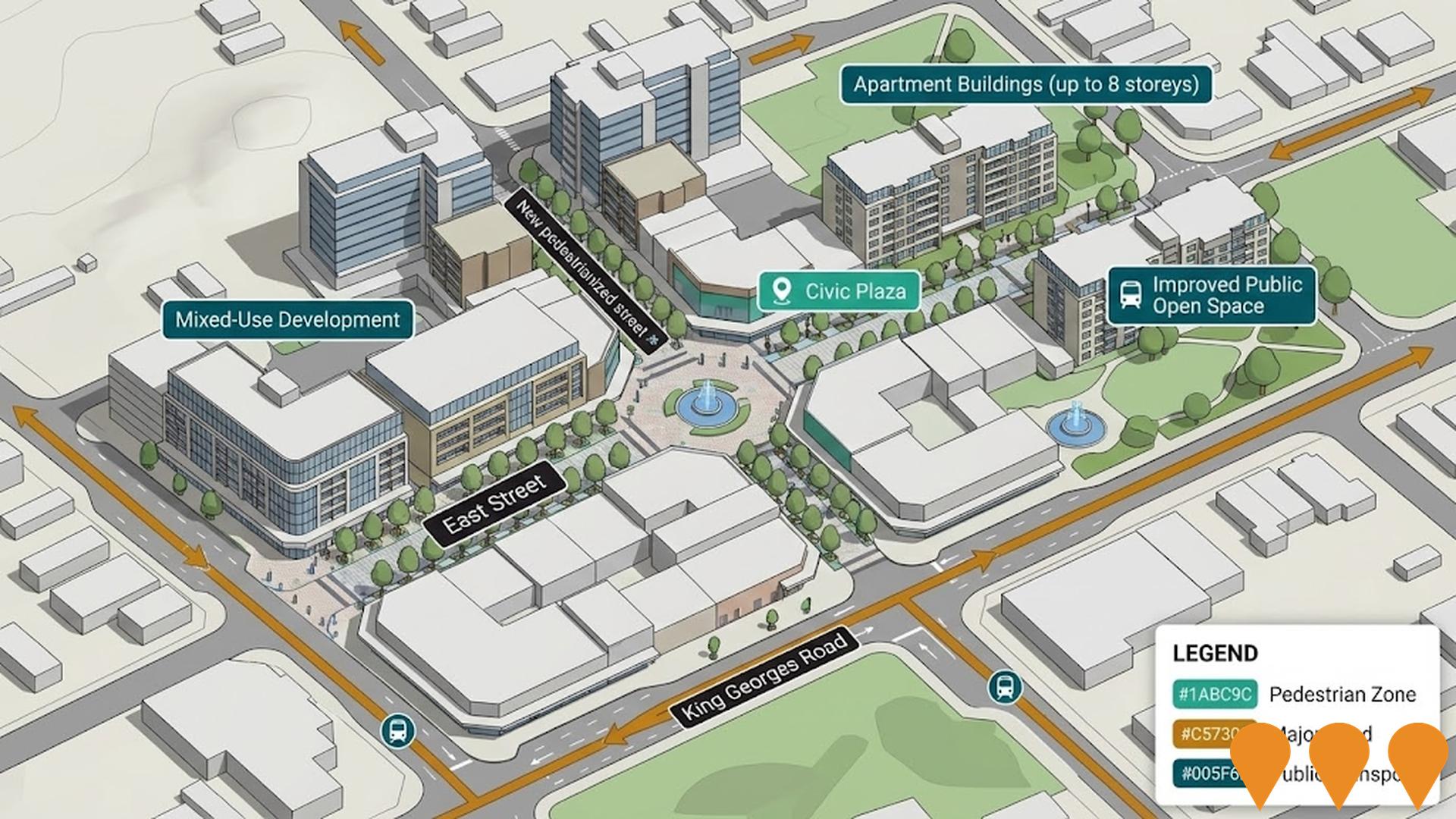
Beverly Hills Commuter Car Park
A new multi-storey commuter car park with 200+ parking spaces located 70 metres from Beverly Hills railway station. Features include CCTV, lighting, wayfinding signage, Opal card-operated boom gates, and provisions for future electric vehicle charging points.
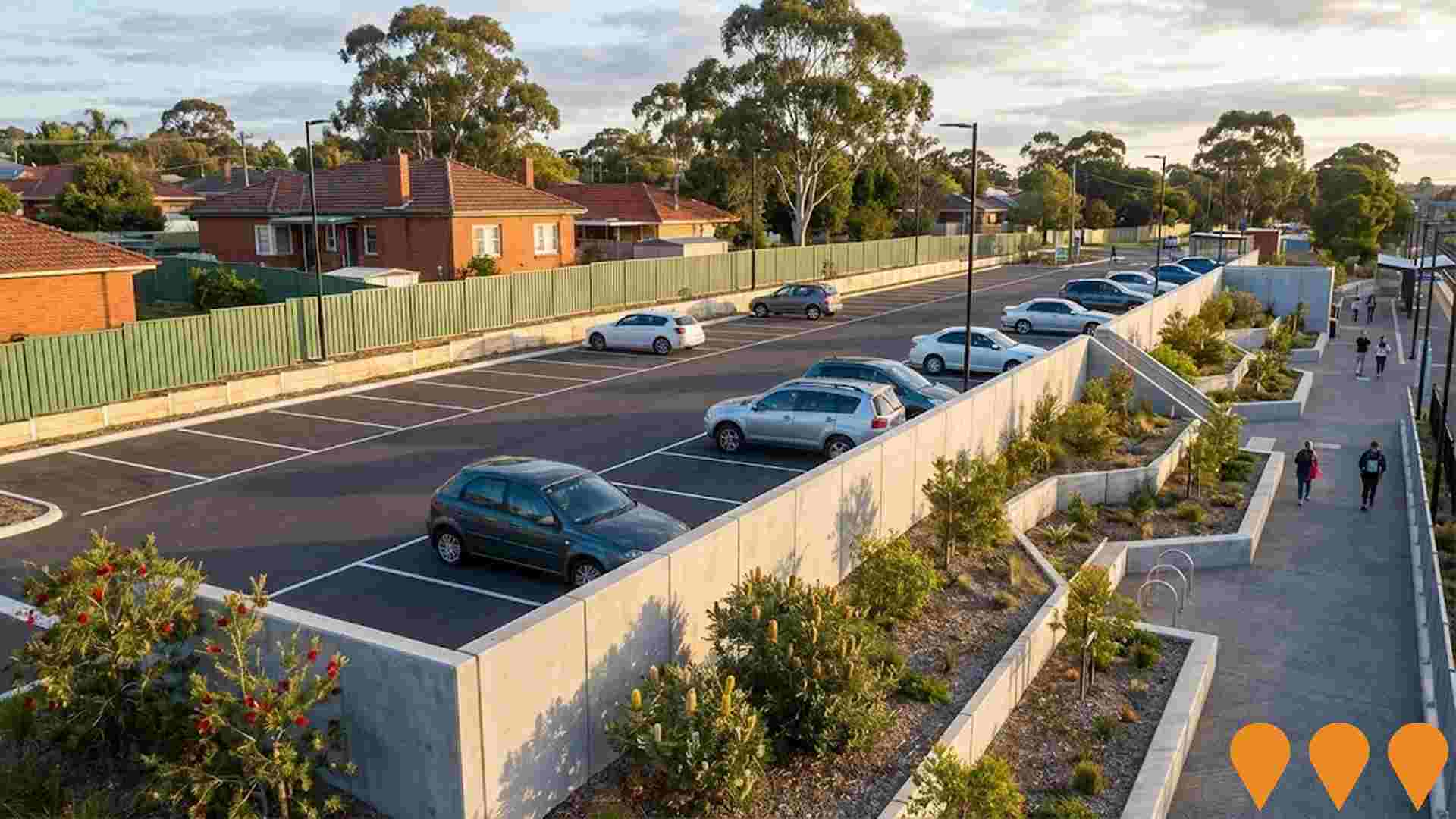
Employment
Employment conditions in Narwee - Beverly Hills remain below the national average according to AreaSearch analysis
Narwee - Beverly Hills has an educated workforce with strong professional services representation. The unemployment rate was 4.1% as of June 2025.
Employment growth over the past year was estimated at 1.7%. In June 2025, 7,543 residents were employed, with an unemployment rate of 4.1%, 0.1% below Greater Sydney's rate of 4.2%. Workforce participation was 52.4%, compared to Greater Sydney's 60.0%. Leading employment industries included health care & social assistance, retail trade, and professional & technical services.
The area had a notable concentration in transport, postal & warehousing, with employment levels at 1.6 times the regional average. However, professional & technical services showed lower representation at 9.6% versus the regional average of 11.5%. Employment opportunities locally appeared limited, as indicated by the count of Census working population vs resident population. Between June 2024 and June 2025, employment levels increased by 1.7%, while labour force increased by 2.6%, causing the unemployment rate to rise by 0.9 percentage points. In contrast, Greater Sydney experienced employment growth of 2.6% and labour force growth of 2.9%, with a 0.3 percentage point rise in unemployment rate. National employment forecasts from Jobs and Skills Australia, published in May 2025, project national employment to expand by 6.6% over five years and 13.7% over ten years. Applying these projections to Narwee - Beverly Hills's employment mix suggests local growth of approximately 6.7%% over five years and 13.7% over ten years.
Frequently Asked Questions - Employment
Income
Income levels sit below national averages according to AreaSearch assessment
AreaSearch's latest postcode level ATO data for financial year 2022 shows that Narwee - Beverly Hills has an income below the national average. The median income is $46,648 and the average income stands at $60,311. This contrasts with Greater Sydney's figures of a median income of $56,994 and an average income of $80,856. Based on Wage Price Index growth of 12.61% since financial year 2022, current estimates would be approximately $52,530 (median) and $67,916 (average) as of September 2025. According to the 2021 Census figures, household income ranks at the 44th percentile ($1,646 weekly), while personal income sits at the 24th percentile. Income brackets indicate that the largest segment comprises 29.0% earning $1,500 - $2,999 weekly (4,051 residents). This aligns with the surrounding region where this cohort likewise represents 30.9%. Housing affordability pressures are severe, with only 81.8% of income remaining, ranking at the 42nd percentile. The area's SEIFA income ranking places it in the 6th decile.
Frequently Asked Questions - Income
Housing
Narwee - Beverly Hills displays a diverse mix of dwelling types, with above-average rates of outright home ownership
Narwee - Beverly Hills dwelling structure, as per the latest Census, had 57.6% houses and 42.3% other dwellings (semi-detached, apartments, 'other' dwellings). Sydney metro had 52.1% houses and 47.9% other dwellings. Home ownership in Narwee - Beverly Hills was 33.6%, similar to Sydney metro. Mortgaged dwellings were 28.6% and rented ones were 37.8%. The median monthly mortgage repayment was $2,253, lower than Sydney metro's $2,466. Median weekly rent was $400, compared to Sydney metro's $440. Nationally, Narwee - Beverly Hills had higher mortgage repayments ($1,863) and rents ($375).
Frequently Asked Questions - Housing
Household Composition
Narwee - Beverly Hills has a typical household mix, with a lower-than-average median household size
Family households account for 73.2% of all households, including 37.3% couples with children, 21.8% couples without children, and 12.6% single parent families. Non-family households make up the remaining 26.8%, with lone person households at 24.1% and group households comprising 2.6%. The median household size is 2.7 people, which is smaller than the Greater Sydney average of 2.8.
Frequently Asked Questions - Households
Local Schools & Education
Narwee - Beverly Hills performs slightly above the national average for education, showing competitive qualification levels and steady academic outcomes
Educational qualifications in Narwee-Beverly Hills show that 32.8% of residents aged 15 and above have university degrees, compared to the Greater Sydney average of 38.0%. Bachelor degrees are most common at 23.0%, followed by postgraduate qualifications at 7.6% and graduate diplomas at 2.2%. Vocational credentials are also prevalent, with 27.0% of residents holding such qualifications, including advanced diplomas at 11.4% and certificates at 15.6%. Educational participation is high, with 28.1% of residents currently enrolled in formal education, including 8.3% in primary, 7.2% in secondary, and 6.2% in tertiary education.
The area has three schools with a combined enrollment of 1,897 students, serving distinct age groups and demonstrating typical Australian school conditions (ICSEA: 1035).
Frequently Asked Questions - Education
Schools Detail
Nearby Services & Amenities
Transport
Transport servicing is high compared to other areas nationally based on assessment of service frequency, route connectivity and accessibility
Narwee-Beverly Hills has 72 active public transport stops. These are a mix of train and bus stations. They are served by 22 different routes, which together provide 3,964 weekly passenger trips.
Residents have excellent transport accessibility, with an average distance of 155 meters to the nearest stop. The service frequency is 566 trips per day across all routes, equating to about 55 weekly trips per individual stop.
Frequently Asked Questions - Transport
Transport Stops Detail
Health
Narwee - Beverly Hills's residents are extremely healthy with both young and old age cohorts seeing low prevalence of common health conditions
Analysis shows Narwee - Beverly Hills has low prevalence of common health conditions across young and old age groups. Approximately 50% (~6,985 people) have private health cover, compared to Greater Sydney's 53.6% and Australia's average of 55.3%. Arthritis and diabetes are the most prevalent conditions, affecting 6.2% and 5.4% respectively.
75.0% of residents report no medical ailments, slightly lower than Greater Sydney's 77.2%. The area has a higher proportion of seniors aged 65 and over at 20.6% (2,882 people), compared to Greater Sydney's 19.1%. Senior health outcomes align with the general population's profile.
Frequently Asked Questions - Health
Cultural Diversity
Narwee - Beverly Hills is among the most culturally diverse areas in the country based on AreaSearch assessment of a range of language and cultural background related metrics
Narwee-Beverly Hills is among the most culturally diverse areas in Australia, with 50.3% of its population born overseas and 61.2% speaking a language other than English at home. Christianity is the predominant religion in Narwee-Beverly Hills as of 2016 Census data, comprising 53.0% of the population. However, Buddhism is notably overrepresented compared to Greater Sydney, with 6.7% of Narwee-Beverly Hills residents identifying as Buddhist versus 5.4%.
The top three ancestral groups in Narwee-Beverly Hills are Chinese (26.9%), Other (16.7%), and Australian (10.7%). There are also notable divergences from regional averages for Greek (6.7% vs 5.6%), Lebanese (4.5% vs 3.2%), and Macedonian (1.4% vs 2.3%) ancestry groups.
Frequently Asked Questions - Diversity
Age
Narwee - Beverly Hills's population is slightly older than the national pattern
Narwee - Beverly Hills has a median age of 40, which is slightly higher than Greater Sydney's figure of 37 and Australia's figure of 38 years. Compared to Greater Sydney's average, the 65-74 age cohort is notably over-represented in Narwee-Beverly Hills at 11.0%, while the 35-44 age group is under-represented at 12.7%. Between 2021 and present, the 15 to 24 age group has increased from 11.3% to 13.4% of the population. Conversely, the 35 to 44 age cohort has decreased from 13.8% to 12.7%. Demographic modeling indicates that Narwee-Beverly Hills' age profile will significantly change by 2041. The 75 to 84 age cohort is projected to grow significantly, expanding by 621 people (70%) from 881 to 1,503. Notably, the combined 65+ age groups are expected to account for 77% of total population growth, reflecting the area's aging demographic profile. Meanwhile, the 25 to 34 and 0 to 4 age cohorts are expected to experience population declines.
